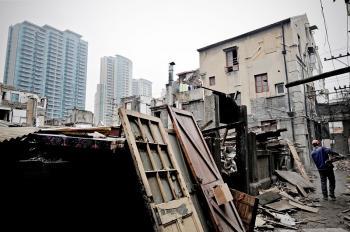A new round of home buying restrictions has been extended to second and third tier cities in China. The cities of Zhengzhou (Henan Province), Taiyuan (Shanxi Province), Wuhan (Hubei Province) and Kunming (Yunnan Province) have recently released details of the new restrictions. Qingdao and Jinan in Shandong province confirmed that they will impose restrictions later, while Changsha (Hunan Province), Xi’an (Shanxi Province), and Nanning (Guangxi Province) are believed to be close to introducing them.
Effective Jan. 15, every household is allowed to buy only one home in the central urban area of Wuhan, a second-tier city, regardless of its size, according to the notice originally posted onto Sina.com’s real estate section. The average sales price for commercial residential housing in Wuhan last year was 6,184 yuan (US $938.96) per square meter, an increase of 17.44 percent compared with the year before.
When the news reached Qingdao, Sun, on staff with the Good Friend Housing Service Company told Voice of America (VOA), “Qingdao’s housing price will only rise, not fall, because no more houses can be bought in good locations. This restriction can only target high-priced homes and will even be extended to the suburbs. Residential housing can only rise, and it will not fall until the next century. As for those high-quality houses, costing 30,000 to 40,000 yuan (US $4,556.58 to $6,075.25) per square meter—even if you lower it to 20,000 yuan (US $3,038) people still cannot afford it.”
The Chinese Academy of Sciences predicted that in 2011, house prices in China will continue to rise by as much as 12.7 percent. It is expected to be linked with China’s consumer price index, which is estimated to rise 3.7 percent.
Most Chinese cannot afford residential homes, yet low-rent and other economical houses that are supposed to assist low-income families have been snapped up by the rich.
The ruling Party’s mouthpiece Xinhua News reported that there’s no telling how many “distinguished” people are living in these low-income houses; some BMW and Mercedes-Benz owners are also trying to acquire these kinds of houses.
Close to 90 percent of the applicants for low-income houses in Shanghang of Fujian province in 2010 are public servants. Some of their names even appear multiple times on the applicant list, according to the VOA article.
In 2010, the State Council launched a series of housing market regulations; in addition to home buying restrictions, there were also measures including: suspending loans for the purchase of a third property, increasing the down payment, and limiting the maximum loan amount on residential housing.
Yet having so many regulatory policies still cannot keep rising prices under control. Chinese media reported that officials from China’s Ministry of Housing and Urban-Rural Construction said in an internal meeting in mid-January that they would pressure local officials to impose restrictions.
Financial commentator Ni Jinjie wrote that, based on the effect of the regulations in 2010, the measures are merely a formality. Since the root cause of uncontrollable house prices is that local governments are important beneficiaries, naturally the regulations were not implemented strictly.
Takings from land sales soared 70 percent last year, and this form of easy lucre has become the most important source of revenue for many local governments.
Ni’s article stated that currency flooding and land financing are the two main factors supporting China’s real estate bubble. In the past two years, China’s state-owned banks gave out 17 trillion yuan (US $2.58 trillion) in new loans; during the time when the real economy was sinking and manufacturing margins were thin, this money flowed into real estate.
For local governments, land is still their largest source of revenue. Since local officials’ promotion is tied to the local GDP performance, “land sales” weigh much more than people’s livelihood and affordable housing.
Liu Feiyue, in charge of the Civil Rights and Livelihood Watch website, told VOA that the authorities did not dig out the root of the problem, because the government itself is the beneficiary of high housing prices.
“The most fundamental problem is the profit chain,” Liu said. “Not only local governments, but the central government also benefits tremendously from it.”
[email protected]
Effective Jan. 15, every household is allowed to buy only one home in the central urban area of Wuhan, a second-tier city, regardless of its size, according to the notice originally posted onto Sina.com’s real estate section. The average sales price for commercial residential housing in Wuhan last year was 6,184 yuan (US $938.96) per square meter, an increase of 17.44 percent compared with the year before.
When the news reached Qingdao, Sun, on staff with the Good Friend Housing Service Company told Voice of America (VOA), “Qingdao’s housing price will only rise, not fall, because no more houses can be bought in good locations. This restriction can only target high-priced homes and will even be extended to the suburbs. Residential housing can only rise, and it will not fall until the next century. As for those high-quality houses, costing 30,000 to 40,000 yuan (US $4,556.58 to $6,075.25) per square meter—even if you lower it to 20,000 yuan (US $3,038) people still cannot afford it.”
The Chinese Academy of Sciences predicted that in 2011, house prices in China will continue to rise by as much as 12.7 percent. It is expected to be linked with China’s consumer price index, which is estimated to rise 3.7 percent.
Most Chinese cannot afford residential homes, yet low-rent and other economical houses that are supposed to assist low-income families have been snapped up by the rich.
The ruling Party’s mouthpiece Xinhua News reported that there’s no telling how many “distinguished” people are living in these low-income houses; some BMW and Mercedes-Benz owners are also trying to acquire these kinds of houses.
Close to 90 percent of the applicants for low-income houses in Shanghang of Fujian province in 2010 are public servants. Some of their names even appear multiple times on the applicant list, according to the VOA article.
In 2010, the State Council launched a series of housing market regulations; in addition to home buying restrictions, there were also measures including: suspending loans for the purchase of a third property, increasing the down payment, and limiting the maximum loan amount on residential housing.
Yet having so many regulatory policies still cannot keep rising prices under control. Chinese media reported that officials from China’s Ministry of Housing and Urban-Rural Construction said in an internal meeting in mid-January that they would pressure local officials to impose restrictions.
Financial commentator Ni Jinjie wrote that, based on the effect of the regulations in 2010, the measures are merely a formality. Since the root cause of uncontrollable house prices is that local governments are important beneficiaries, naturally the regulations were not implemented strictly.
Takings from land sales soared 70 percent last year, and this form of easy lucre has become the most important source of revenue for many local governments.
Ni’s article stated that currency flooding and land financing are the two main factors supporting China’s real estate bubble. In the past two years, China’s state-owned banks gave out 17 trillion yuan (US $2.58 trillion) in new loans; during the time when the real economy was sinking and manufacturing margins were thin, this money flowed into real estate.
For local governments, land is still their largest source of revenue. Since local officials’ promotion is tied to the local GDP performance, “land sales” weigh much more than people’s livelihood and affordable housing.
Liu Feiyue, in charge of the Civil Rights and Livelihood Watch website, told VOA that the authorities did not dig out the root of the problem, because the government itself is the beneficiary of high housing prices.
“The most fundamental problem is the profit chain,” Liu said. “Not only local governments, but the central government also benefits tremendously from it.”
[email protected]



